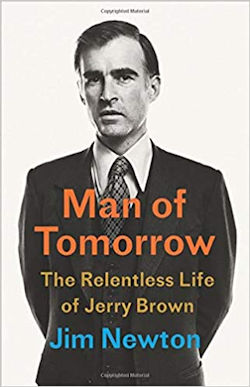SEJournal Online is the digital news magazine of the Society of Environmental Journalists. Learn more about SEJournal Online, including submission, subscription and advertising information.
BookShelf: “Man of Tomorrow: The Relentless Life of Jerry Brown”
By Jim Newton
Little, Brown and Company, $30
Reviewed by Gary Wilson
 |
In July 2012, California Gov. Jerry Brown received the first reports during his second tenure as governor on the state’s progress in dealing with climate change.
They warned of the threat to the state’s water supply due to loss of snowpack in the mountains, higher and drier temperatures during a protracted fire season and the damage to California’s coasts from rising seas.
Those reports “were startling in their revelations about California’s vulnerability to the greatest looming ecological disaster in modern times,” author Jim Newton writes in his recent biography of Brown, entitled “Man of Tomorrow: The Relentless Life of Jerry Brown.”
At the time, an adviser to Brown cautioned that the state was not prepared to accept the scientific findings about climate change, Newton notes. But Brown, early in his first term and 28 years after he had previously been governor, was prepared and, according to Newton, “led at all levels.”
Brown fostered a plan to preserve iconic Lake Tahoe. He issued an executive order to accelerate availability of electric cars and took steps to curb energy purchases.
And in 2017, when President Trump pulled the United States out of the Paris climate accord, Brown was ready for the fight, quickly calling Trump’s action “wrong on the science.”
As governor, Brown tackled the issue in the political realm by promoting an extension of the cap-and-trade plan that he acknowledged was imperfect. He lobbied hard with a reluctant legislature, which feared a negative economic impact, as well as with skeptical environmentalists who said the bill wasn’t enough. The bill passed by a slim margin.
From spiritual learning to practical governing
Brown’s interest in protecting the environment didn’t sprout as the threat of climate change ascended. Its foundation was laid early in his life when he eschewed college to join the seminary preparing to be a priest, a pursuit he abandoned after three years only to continue his spiritual learning in Zen Buddhism.
Brown deduced that ‘the Earth will be just fine’
left to its own devices, [but] that it’s humanity’s
impact on the planet that is the problem.
Out of those teachings, Brown deduced that ”the Earth will be just fine” left to its own devices, that it’s humanity’s impact on the planet that is the problem.
But Newton writes that Brown “was required to be more than a high priest of climate change.”
Ancient teaching must be translated to practical governing.
And Brown got the chance when he inherited a big issue in his first term in 1976, the first coastal protection act designed to safeguard California's 800 miles of coast from development. The law, passed in 1972, outlined a framework for protecting the coast but needed teeth and previous attempts to codify protections had failed.
Newton describes how Brown dealt with the opposition of legislators, the pushback from cities that felt the state was usurping their power and the protests of the oil lobby, which employed a former California governor, Jerry’s father Pat.
Yet the law passed, and Brown “had outfoxed development and oil interests, including those represented by his father — a testament to mastery of the issue’s complex insider politics. The winner was the environment,” Newton writes.
‘Most prominent defender of the Earth itself’
To be sure, Newton’s biography of Brown is just that, a biography. It’s not an environmental book. It includes Brown’s complex relationship with his father, his relationship with rock star Linda Ronstadt and how he acquired the moniker “Governor Moonbeam.”
But Newton had the foresight to see the environment as a pillar in the life of the governor, who was a keynote speaker at the Society of Environmental Journalist’s 2016 conference in Sacramento, Calif., and was in attendance in SEJ’s annual look-ahead event in Washington, D.C., last January.
A former Los Angeles Times reporter, editor and bureau chief, Newton had significant access to Brown, documenting 17 conversations with him between 2015 and February 2020. Newton describes one of those conversations late in Brown’s last term, in which they discussed philosophy and politics, laughed and squabbled.
How do you summarize the life of a governor of the nation-state that is California whose political career spanned decades? Here’s Newton on Brown’s role on climate change:
“He (Brown) would graduate from state leader to international icon. He took office as a young maverick interested in solar energy and space exploration. By the time he finishes, he would be recognized around the world as the nation’s most prominent defender of the Earth itself.”
Newton’s biography is a significant work that can only enhance our understanding of the politics of the environment, and our reporting on it.
Gary Wilson is a senior correspondent for Detroit Public TV’s Great Lakes bureau.
* From the weekly news magazine SEJournal Online, Vol. 5, No. 41. Content from each new issue of SEJournal Online is available to the public via the SEJournal Online main page. Subscribe to the e-newsletter here. And see past issues of the SEJournal archived here.













 Advertisement
Advertisement 



